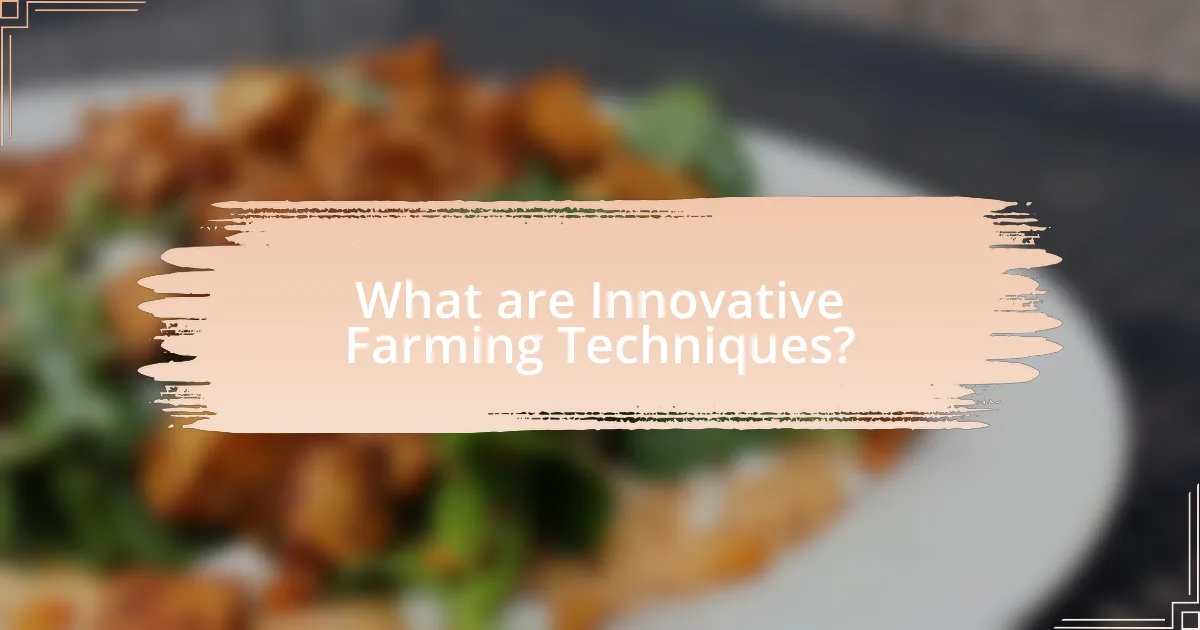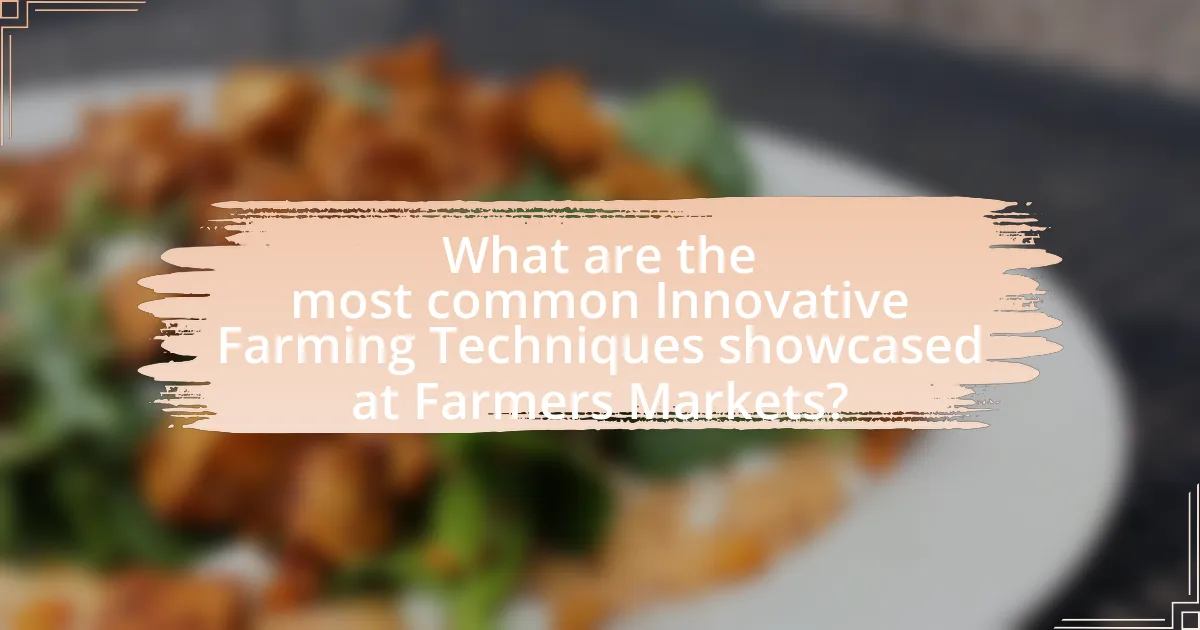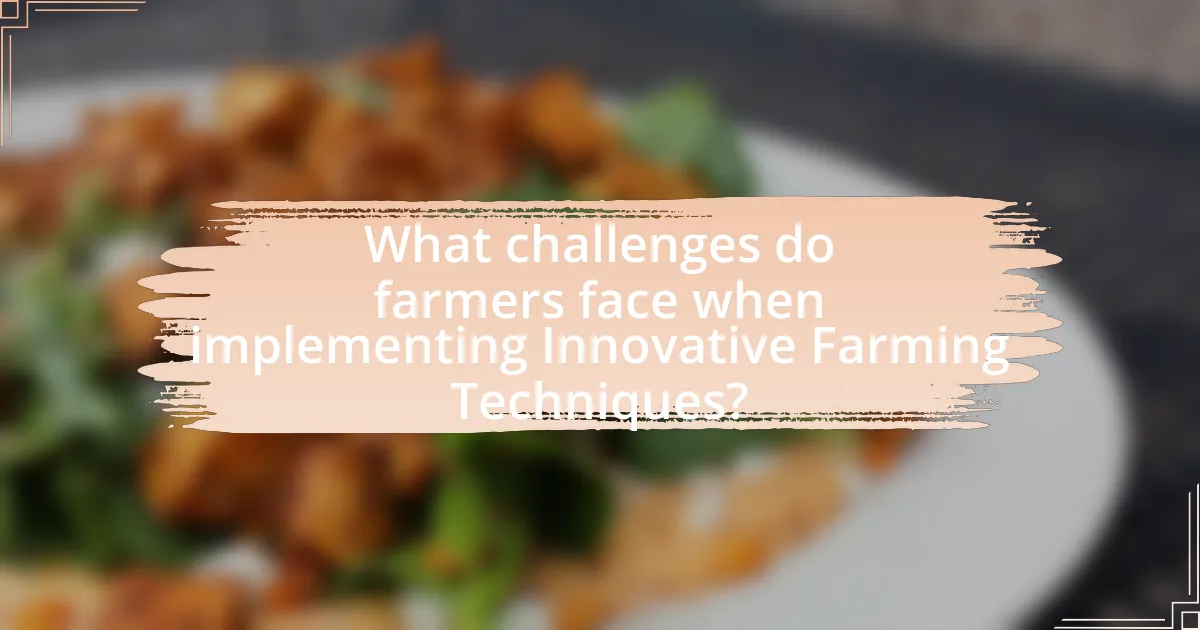Innovative farming techniques are advanced agricultural methods that enhance productivity and sustainability, including precision agriculture, hydroponics, and aquaponics. These techniques differ from traditional farming by utilizing technology and sustainable practices, leading to increased yields and reduced resource waste. Farmers markets play a crucial role in showcasing these methods, allowing direct consumer interaction and education about sustainable practices. The article explores the benefits, challenges, and misconceptions surrounding innovative farming techniques, as well as practical tips for farmers to effectively present their methods at markets.

What are Innovative Farming Techniques?
Innovative farming techniques are advanced methods that enhance agricultural productivity and sustainability. These techniques include precision agriculture, which utilizes technology such as GPS and sensors to optimize field-level management regarding crop farming. Hydroponics and aquaponics are also innovative methods that allow for soil-less farming, enabling higher yields in smaller spaces. According to a report by the Food and Agriculture Organization, these techniques can significantly reduce water usage and increase crop efficiency, demonstrating their effectiveness in modern agriculture.
How do Innovative Farming Techniques differ from traditional methods?
Innovative farming techniques differ from traditional methods primarily through their use of advanced technology and sustainable practices. Traditional farming often relies on conventional methods such as plowing and chemical fertilizers, while innovative techniques incorporate precision agriculture, hydroponics, and organic farming practices. For instance, precision agriculture utilizes data analytics and GPS technology to optimize field-level management regarding crop farming, which can lead to increased yields and reduced resource waste. Additionally, hydroponics allows for soil-less cultivation, significantly reducing water usage by up to 90% compared to traditional soil-based methods. These advancements not only enhance productivity but also promote environmental sustainability, addressing issues such as soil degradation and water scarcity.
What specific practices define Innovative Farming Techniques?
Innovative farming techniques are defined by practices such as precision agriculture, vertical farming, aquaponics, and the use of biotechnology. Precision agriculture employs technology like GPS and sensors to optimize field-level management regarding crop farming. Vertical farming utilizes controlled environments to grow crops in stacked layers, significantly reducing land use. Aquaponics combines aquaculture and hydroponics, creating a sustainable ecosystem for growing fish and plants together. Biotechnology involves genetic modification and other techniques to enhance crop resilience and yield. These practices are supported by research indicating increased efficiency and sustainability in food production, such as a study published in the journal “Agricultural Systems” which highlights the benefits of precision agriculture in reducing resource use while maximizing output.
Why are these techniques gaining popularity among farmers?
These techniques are gaining popularity among farmers due to their ability to enhance productivity and sustainability. Innovative farming techniques, such as precision agriculture and vertical farming, allow farmers to optimize resource use, reduce waste, and increase crop yields. For instance, precision agriculture utilizes data analytics to make informed decisions about planting and resource allocation, leading to a reported increase in yields by up to 20% in some cases. Additionally, vertical farming minimizes land use and water consumption, making it an attractive option in urban areas where space is limited. The growing consumer demand for sustainably produced food further drives the adoption of these methods, as farmers seek to meet market expectations while improving their operational efficiency.
What role do Farmers Markets play in showcasing these techniques?
Farmers markets serve as vital platforms for showcasing innovative farming techniques by providing direct access to consumers and farmers. These markets allow farmers to demonstrate sustainable practices, such as organic farming, permaculture, and hydroponics, which can be observed firsthand by attendees. For instance, a study by the USDA found that farmers markets increase consumer awareness of local agricultural practices, leading to a greater appreciation for innovative techniques. This direct interaction fosters education and encourages the adoption of these methods among consumers and other farmers, thereby promoting sustainable agriculture.
How do Farmers Markets facilitate the introduction of Innovative Farming Techniques?
Farmers markets facilitate the introduction of innovative farming techniques by providing a direct platform for farmers to showcase and sell their unique products, which often incorporate new agricultural practices. This environment encourages knowledge sharing among farmers, consumers, and agricultural experts, fostering discussions about sustainable practices, organic farming, and technology integration. For instance, a study by the USDA found that farmers who participate in markets are more likely to adopt practices such as crop rotation and integrated pest management, as they receive immediate feedback from consumers and peers. This interaction not only promotes innovation but also helps to disseminate successful techniques across the farming community.
What benefits do Farmers Markets provide to farmers using these techniques?
Farmers markets provide significant benefits to farmers utilizing innovative farming techniques by offering direct access to consumers, which enhances profit margins. This direct-to-consumer model allows farmers to sell their products at retail prices rather than wholesale, often resulting in higher earnings. Additionally, farmers markets facilitate the promotion of unique farming practices, enabling farmers to educate consumers about their techniques, which can lead to increased customer loyalty and demand for their products. Research indicates that farmers participating in markets can earn up to 50% more than those selling through traditional distribution channels, highlighting the financial advantages of this approach.

What are the most common Innovative Farming Techniques showcased at Farmers Markets?
The most common innovative farming techniques showcased at farmers markets include vertical farming, hydroponics, aquaponics, and organic regenerative agriculture. Vertical farming utilizes stacked layers to grow crops in controlled environments, maximizing space and resource efficiency. Hydroponics involves growing plants in nutrient-rich water solutions, eliminating the need for soil and allowing for year-round production. Aquaponics combines fish farming with hydroponics, creating a symbiotic environment where fish waste provides nutrients for plants, and plants help filter the water for fish. Organic regenerative agriculture focuses on improving soil health and biodiversity through practices like cover cropping and crop rotation, which enhance sustainability and resilience. These techniques are increasingly popular due to their ability to produce food sustainably and efficiently, addressing the growing demand for local and environmentally friendly produce.
How does vertical farming contribute to sustainability?
Vertical farming contributes to sustainability by significantly reducing land use and resource consumption compared to traditional agriculture. This method utilizes stacked layers to grow crops, which allows for higher yields per square foot, thus minimizing the need for extensive farmland. Additionally, vertical farms often employ hydroponics or aeroponics, which use up to 90% less water than conventional farming methods. According to a study by the National Academy of Sciences, vertical farming can produce food with a lower carbon footprint due to reduced transportation needs, as these farms can be located closer to urban centers. Furthermore, vertical farming systems can operate year-round, leading to consistent food production and reduced reliance on seasonal crops, enhancing food security.
What are the advantages of vertical farming for urban agriculture?
Vertical farming offers several advantages for urban agriculture, including space efficiency, reduced transportation costs, and enhanced food security. By utilizing vertical space, urban farms can produce more food per square foot compared to traditional farming methods, which is crucial in densely populated areas where land is limited. Additionally, vertical farms can be located closer to consumers, minimizing the distance food travels and thereby lowering transportation emissions and costs. This proximity also contributes to improved food security, as fresh produce can be grown and harvested locally, reducing reliance on external food sources. Studies indicate that vertical farming can yield up to 10 times more produce than conventional farming on the same footprint, highlighting its potential to address urban food demands effectively.
How does vertical farming impact resource usage?
Vertical farming significantly reduces resource usage compared to traditional farming methods. It utilizes up to 90% less water due to closed-loop irrigation systems that recycle water, minimizing waste. Additionally, vertical farms can produce crops in urban areas, reducing transportation emissions and energy costs associated with moving food from rural farms to cities. Research indicates that vertical farming can yield up to 10 times more produce per square foot than conventional farming, optimizing land use and decreasing the need for arable land. This efficiency in resource usage highlights the sustainability potential of vertical farming in addressing food security and environmental concerns.
What is aquaponics and how is it demonstrated at Farmers Markets?
Aquaponics is a sustainable farming method that combines aquaculture (raising fish) and hydroponics (growing plants in water) in a symbiotic environment. At Farmers Markets, aquaponics is demonstrated through live displays of integrated systems where fish and plants coexist, showcasing how fish waste provides nutrients for plants while plants help filter and clean the water for fish. This method highlights the efficiency of resource use, as it requires significantly less water than traditional farming, with studies indicating up to 90% water savings. Additionally, Farmers Markets often feature educational materials and workshops that explain the aquaponics process, allowing consumers to understand its benefits and applications in sustainable agriculture.
What are the key components of an aquaponics system?
The key components of an aquaponics system are fish, plants, and a biofilter. Fish provide nutrients through their waste, which is converted into usable forms for plants by beneficial bacteria in the biofilter. This symbiotic relationship allows for efficient nutrient cycling, where plants absorb the nutrients and help purify the water for the fish. Research indicates that aquaponics can produce up to 10 times more food per square foot than traditional farming methods, demonstrating its effectiveness as an innovative farming technique.
How does aquaponics benefit local ecosystems?
Aquaponics benefits local ecosystems by promoting biodiversity and reducing waste. This farming technique combines aquaculture and hydroponics, creating a symbiotic environment where fish waste provides nutrients for plants, while plants filter and purify the water for fish. Research indicates that aquaponics systems can enhance local biodiversity by supporting various plant and fish species, which can lead to healthier ecosystems. Additionally, aquaponics minimizes the need for chemical fertilizers and pesticides, reducing chemical runoff into local waterways, thereby protecting aquatic habitats and improving water quality.

What challenges do farmers face when implementing Innovative Farming Techniques?
Farmers face several challenges when implementing innovative farming techniques, including high initial costs, lack of technical knowledge, and resistance to change. High initial costs can deter farmers from adopting new technologies, as investments in equipment and training can be substantial. Additionally, many farmers may lack the technical expertise required to effectively utilize these innovative methods, leading to suboptimal results. Resistance to change is also prevalent, as traditional farming practices are deeply ingrained, making it difficult for some farmers to embrace new approaches. These challenges are supported by studies indicating that financial constraints and educational gaps significantly hinder the adoption of innovative practices in agriculture.
How can farmers overcome the initial costs of adopting these techniques?
Farmers can overcome the initial costs of adopting innovative farming techniques by accessing financial assistance programs, grants, and low-interest loans specifically designed for agricultural advancements. For instance, the USDA offers various funding opportunities, such as the Environmental Quality Incentives Program (EQIP), which provides financial assistance to implement conservation practices. Additionally, farmers can collaborate with local agricultural extension services to identify cost-sharing programs that reduce upfront expenses. Research indicates that farmers who utilize these financial resources can significantly mitigate the burden of initial investments, enabling them to adopt new technologies more effectively.
What financial assistance options are available for farmers?
Farmers have access to various financial assistance options, including government grants, low-interest loans, and subsidies. These options are designed to support agricultural development and innovation. For instance, the U.S. Department of Agriculture (USDA) offers programs like the Farm Service Agency (FSA) loans, which provide financial support for purchasing land and equipment. Additionally, grants such as the Specialty Crop Block Grant Program help farmers invest in innovative practices. According to the USDA, in 2021, over $1 billion was allocated to support farmers through various financial assistance programs, demonstrating the government’s commitment to enhancing agricultural productivity and sustainability.
How can community support play a role in overcoming these challenges?
Community support can significantly aid in overcoming challenges faced by innovative farming techniques showcased at farmers markets by fostering collaboration and resource sharing among local farmers. This support can manifest through initiatives such as community-sponsored agriculture (CSA) programs, which provide farmers with upfront capital and a guaranteed market for their produce, thereby reducing financial risks associated with adopting new farming methods. Additionally, local workshops and training sessions organized by community groups can enhance farmers’ knowledge and skills in implementing innovative techniques, leading to improved crop yields and sustainability. Research indicates that communities with strong support networks experience higher rates of successful agricultural innovation, as evidenced by a study published in the Journal of Agricultural and Environmental Ethics, which highlights the positive correlation between community engagement and the adoption of sustainable farming practices.
What are the common misconceptions about Innovative Farming Techniques?
Common misconceptions about innovative farming techniques include the belief that they are overly complex and require advanced technology, which can deter traditional farmers from adopting them. In reality, many innovative techniques, such as crop rotation and integrated pest management, are straightforward and can be implemented with minimal technological investment. Additionally, some people think that innovative farming is only suitable for large-scale operations, but numerous methods are designed for small farms and can enhance productivity and sustainability. Furthermore, there is a misconception that these techniques are not environmentally friendly; however, many innovative practices, like organic farming and permaculture, focus on sustainability and reducing chemical inputs, thereby benefiting the ecosystem.
Why do some people believe these techniques are not viable?
Some people believe these innovative farming techniques are not viable due to concerns about their scalability and economic feasibility. Critics argue that while these methods may work on a small scale, such as at farmers markets, they often require significant investment in technology and infrastructure that may not be sustainable for larger agricultural operations. Additionally, studies indicate that traditional farming practices are often more reliable in terms of yield and cost-effectiveness, leading skeptics to question the long-term viability of these innovative approaches.
How can education and outreach help dispel these misconceptions?
Education and outreach can effectively dispel misconceptions about innovative farming techniques by providing accurate information and fostering direct engagement between farmers and consumers. Through workshops, demonstrations, and informational materials at farmers markets, individuals can learn about the benefits and science behind these techniques, such as sustainable practices and crop diversity. Research indicates that direct interaction with knowledgeable farmers increases consumer trust and understanding, as evidenced by a study published in the Journal of Agricultural Education and Extension, which found that 75% of participants reported a better understanding of farming practices after attending educational events. This direct exposure helps to clarify misunderstandings and promotes informed decision-making among consumers.
What practical tips can farmers consider when showcasing their techniques at Farmers Markets?
Farmers can enhance their showcasing of techniques at Farmers Markets by engaging customers through interactive demonstrations. For instance, live demonstrations of planting, harvesting, or cooking with their produce can attract attention and educate consumers about their methods. Research indicates that interactive experiences increase customer engagement by up to 70%, leading to higher sales and customer loyalty. Additionally, providing clear, informative signage that explains the techniques used and the benefits of sustainable practices can further inform and attract customers. This approach not only showcases innovative farming techniques but also builds trust and transparency with consumers.